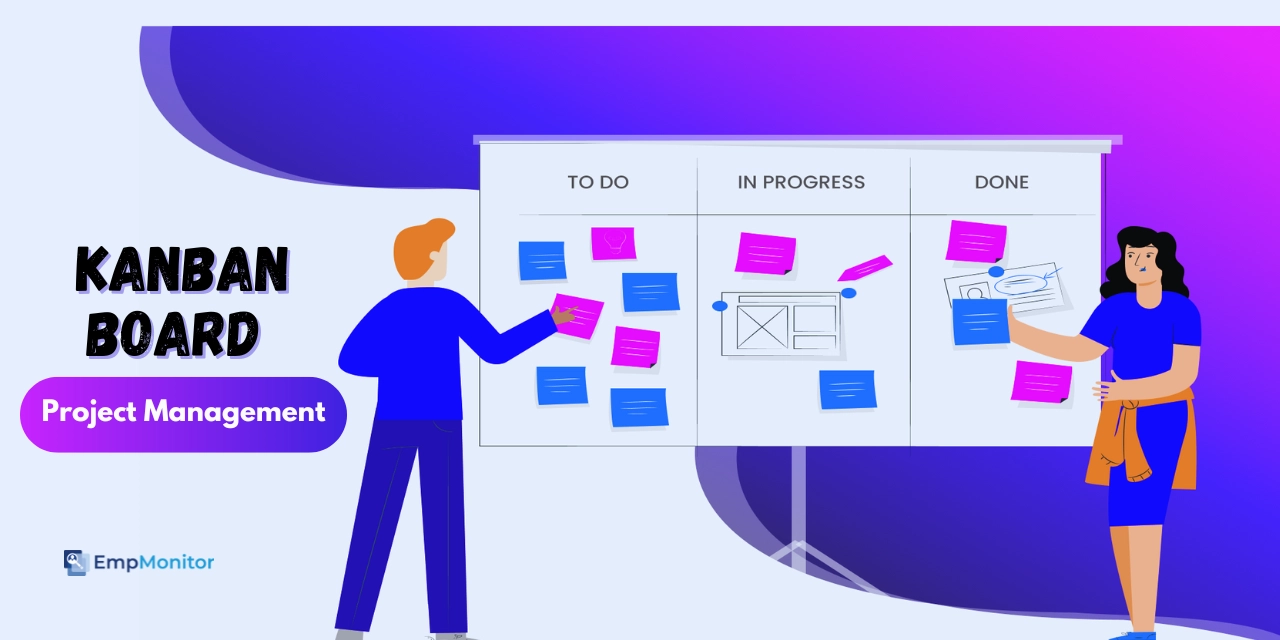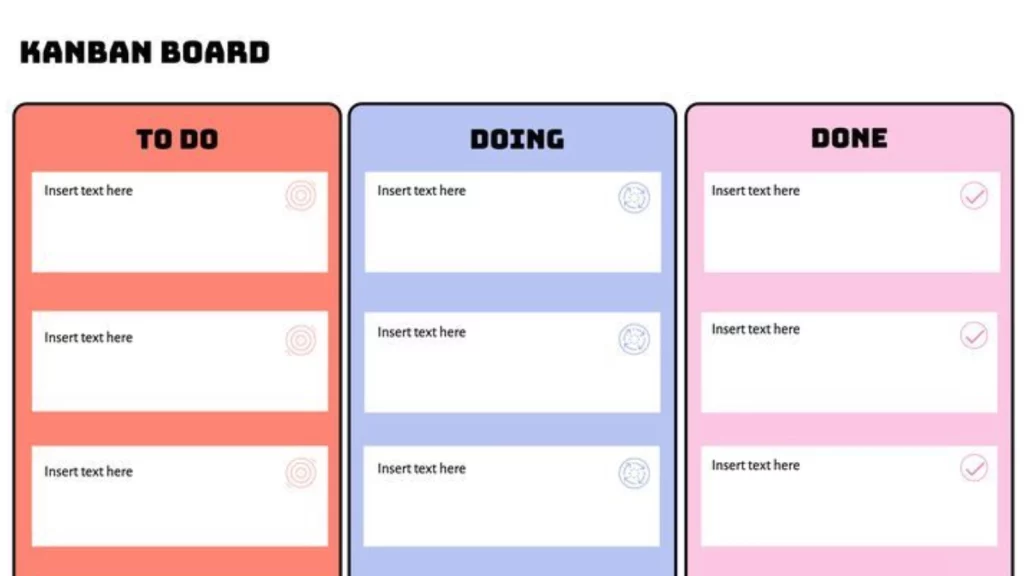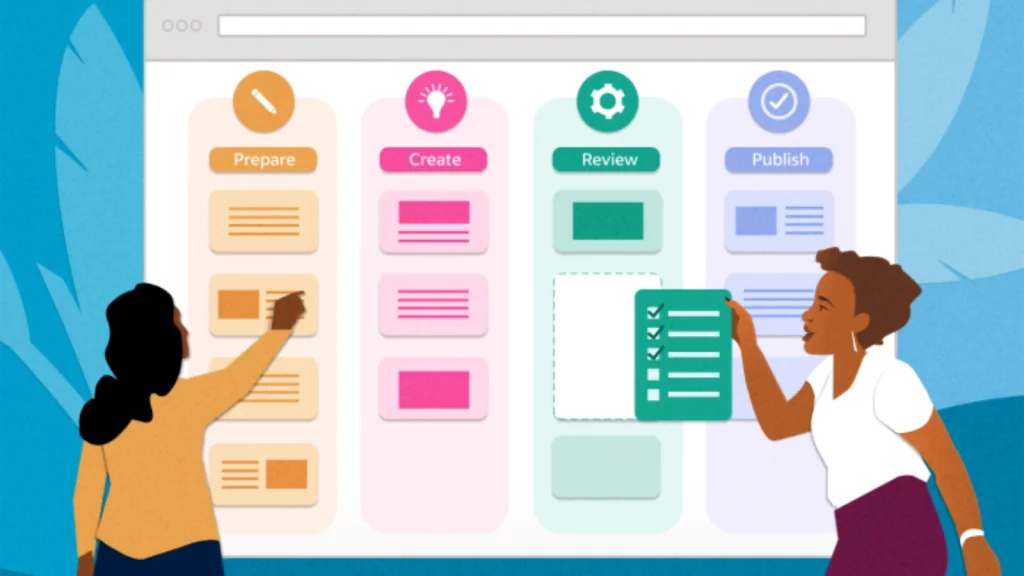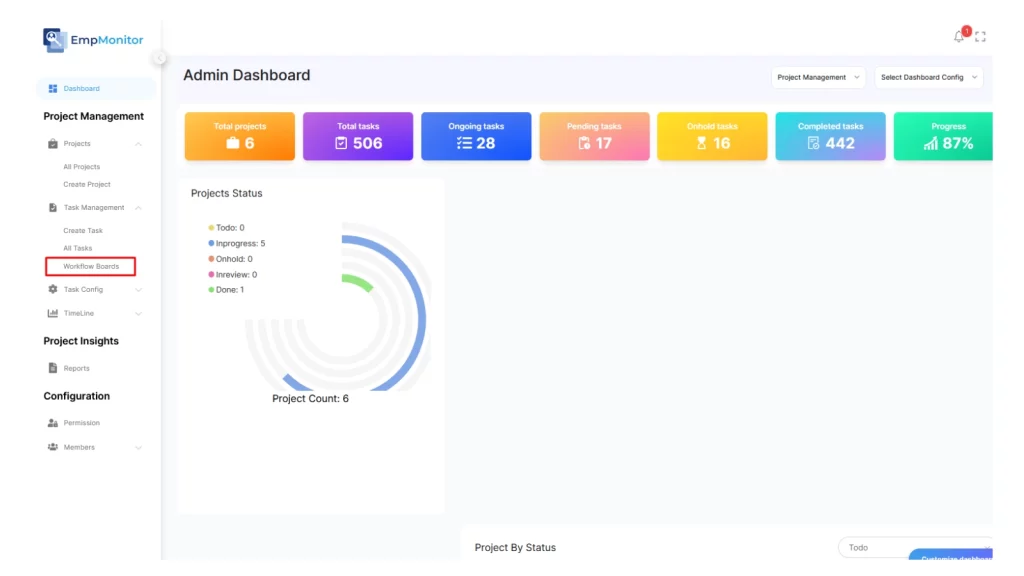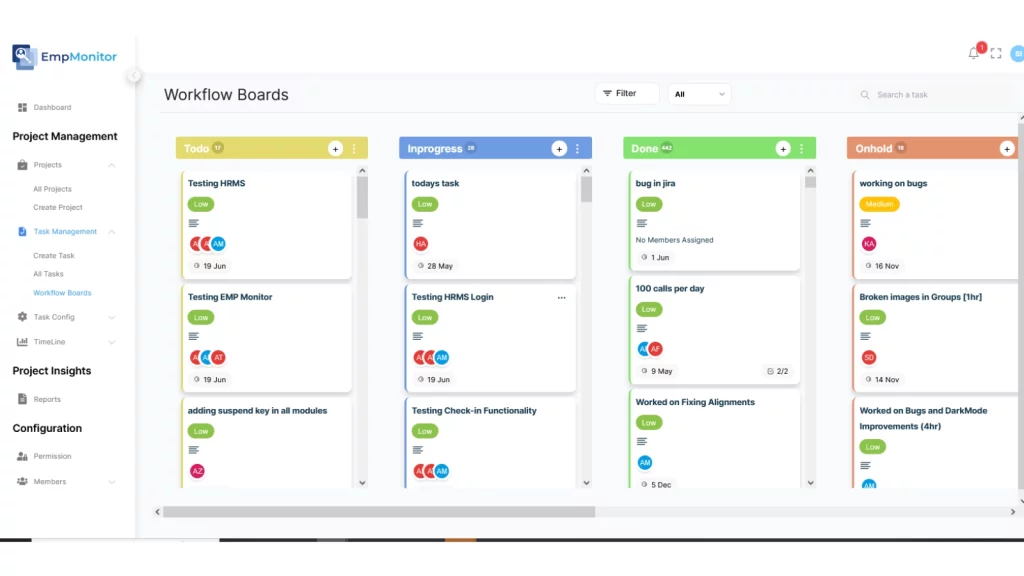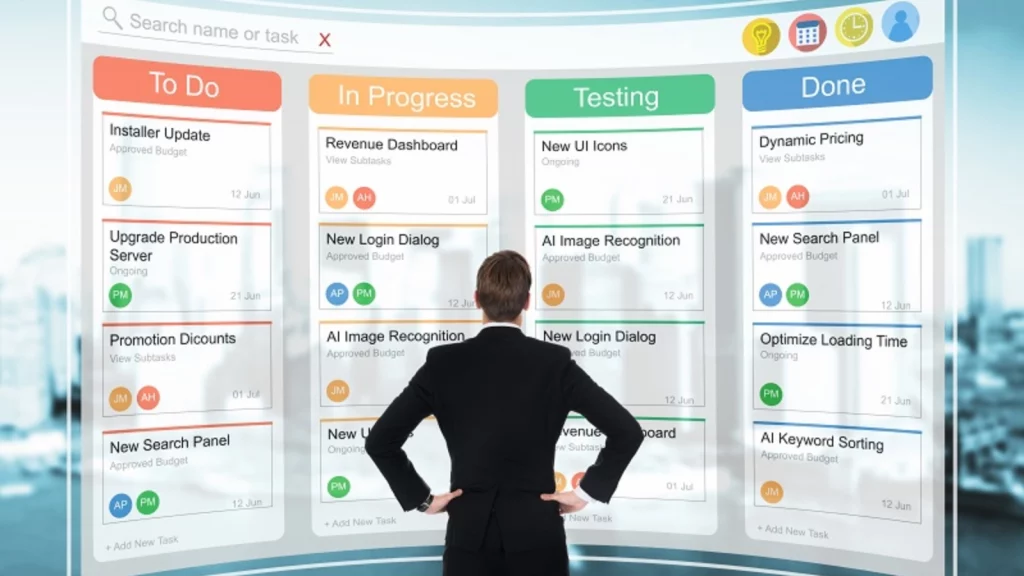Effective project management is essential for success in today’s fast-paced business world. Amidst the complexity of the business landscape and methodologies, teams often find themselves bogged down rather than propelled forward.
This is where Kanban board project management steps in – a dynamic and intuitive system derived from Toyota’s lean management principles, designed to streamline workflows and optimize efficiency.
But what exactly makes Kanban project management a game-changer?
In this blog, we’re diving deep into the world of Kanban, uncovering its transformative power and practical applications across diverse industries.
Let’s explore the nuances of Kanban project management, from its creation of visual boards that provide clarity and transparency to the meticulous management of work in progress. Harness the power of Kanban and pave the way for transformative change in your organization.
So, without any delay, let’s get started!
In a hurry? Listen to the blog instead!
What Is Kanban Board Project Management?
Kanban project management is a specialized method for overseeing and organizing projects built upon the principles of the Kanban methodology. It offers a unique approach that is suitable for businesses of any size. The flexibility and agility of kanban boards make them adaptable to projects of varying complexities and industries.
The essence of Kanban lies in its ability to visualize workflows and manage tasks effectively. It makes it equally applicable in diverse fields such as manufacturing, construction, and software development. Leverage Kanban practices to effectively manage work in progress, identify bottlenecks, and optimize processes for enhanced productivity and efficiency.
A Kanban board template can help you maintain a clear overview of your projects while promoting continuous improvement and adaptability to changing requirements. It empowers organizations to keep track of their projects effectively, ensuring they can adapt to changes and continuously improve their processes.
Why Managers Choose Kanban Board Project Management Over Others?
Kanban project management offers several benefits that contribute to its importance in enhancing workflow efficiency and project success. Here’s why you need Kanban:
Visualization of Workflow
Kanban provides a visual representation of your work process, allowing you to see tasks moving through different stages of completion. This visualization helps you understand workflows, identify bottlenecks, and visualize task dependencies.
Improved Organization
With Kanban, you can organize and prioritize tasks effectively. By visualizing tasks on a Kanban board, teams can easily see the tasks in progress, pending, and completed. This organized approach enables teams to focus on high-priority tasks and ensures that work progresses smoothly.
Tools like EmpMonitor can further enhance this process by tracking productivity and providing insights into team performance, helping to maintain efficiency across all tasks.
Efficient Task Management
Kanban board project management allows teams to keep track of every project and task effortlessly. Each task is represented as a card on the Kanban board, making it easy to monitor progress, assign responsibilities, and track deadlines. This transparency ensures that everyone is on the same page and facilitates better communication and collaboration within the team.
Identification of Inefficiencies
By visualizing workflow on a Kanban board, teams can quickly spot inefficiencies and workflow issues. Whether it’s tasks getting stuck in a particular stage or excessive work in progress, Kanban highlights areas for improvement. This proactive approach enables teams to address issues promptly and optimize their processes for greater efficiency.
Hence, kanban board project management offers a visual, organized, and efficient approach to managing tasks and projects. By providing visibility into the workflow, improving organization, facilitating task management, and identifying inefficiencies, Kanban empowers teams to work more effectively and achieve better project results.
What Are The Elements Of The Kanban Board?
Now that you have understood why kanban project management stays at the fingertip of managers, let’s understand its elements:
1. Visual Signals
Visual signals, typically represented by cards like stickies or tickets, embody projects or work items. Each card often encapsulates a single user story for agile teams, aiding in quick comprehension of ongoing tasks.
2. Columns
Columns delineate distinct activities constituting the workflow, guiding the progression of cards from initiation to completion. Workflow columns can range from basic (“To Do,” “In Progress,” “Complete”) to multifaceted structures tailored to specific project needs.
3. Work In Progress (WIP) Limits
WIP limits establish the maximum number of cards permitted in a column simultaneously, indicating workload capacity. Breaching WIP limits is a warning sign of potential bottlenecks, prompting focused efforts to resolve tasks before introducing new ones.
4. Commitment Point
Kanban board project management symbolizes the juncture at which a project or idea transitions from the backlog to active work by the team. It marks the official commencement of work on the selected project or task.
5. Delivery Point
Kanban boards connote the conclusion of the team’s workflow, typically upon the delivery of the product or service to the customer. The objective is to swiftly progress cards from the commitment point to the delivery point, minimizing lead time for efficient project delivery.
Understanding the elements of the Kanban board empowers teams to effectively visualize, manage, and streamline their workflow using Kanban methodologies.
What Are The Principles Of Kanban Board Project Management?
Before delving into kanban boards, cards, and WIP limits, it’s essential to understand the foundational principles of the kanban methodology.
Start with Current Processes: The initial step in implementing Kanban is to focus on the organization’s existing processes. Rather than immediately changing procedures, kanban encourages visualizing the current workflow to identify areas for improvement.
Organic Changes Over Time: Kanban emphasizes continuous improvement through gradual, incremental changes. Instead of abrupt transformations, the methodology advocates for observing workflows and making small adjustments over time.
Respect Existing Roles: Implementing Kanban does not necessitate altering the organizational structure. Roles and responsibilities remain intact, with changes occurring gradually as part of the continuous improvement process.
Promote Leadership at All Levels: Kanban fosters a collaborative environment where every team member can contribute ideas for improvement. This inclusive approach encourages continuous improvement and maximizes efficiency across the organization.
How To Implement Kanban Board Project Management?
Let’s dive deeper into each step of implementing Kanban board project management:
Setting up Kanban Boards:
Determine the scope of your project and decide whether you’ll use physical boards, digital tools, or specialized software for your Kanban boards. Create separate boards for each project or team, ensuring clarity and focus on specific tasks. Define columns on each board to represent different stages of your workflow, such as “Backlog,” “In Progress,” “Review,” and “Done.”
Designing Workflows:
Customize the workflow stages on your Kanban board to match the unique requirements of your project and team. Consider the sequence of activities involved in completing tasks and arrange the workflow stages accordingly.
Kanban board project management keeps the workflow simple and intuitive, avoiding unnecessary complexity that could hinder progress tracking.
Utilizing Kanban Features:
Explore advanced features in your Kanban tool, such as swimlanes, WIP limits, and priority markers. Implement WIP (Work In Progress) limits for each workflow stage to prevent overloading team members and maintain a balanced workflow.
Use swimlanes to organize tasks based on diverse criteria, such as priority, team member, or project phase.
Adding Tasks and Cards:
Populate your Kanban board with tasks or cards representing individual work items. Include essential details on each card, like task description, assignee, due date, and dependencies.
Prioritize tasks based on urgency, importance, or project goals, ensuring that the most critical items receive prompt attention.
Monitoring and Tracking Progress:
Efficiently monitor task progress within the Kanban board project management system by regularly updating their statuses as they progress through workflow stages. Utilize visual cues such as color-coded cards or labels to signify task statuses like To Do, In Progress, Blocked, and Done for easy identification.
Encourage team members to consistently update task progress and promptly communicate any issues or blockers they encounter. Moreover, there are project management tools like EmpMonitor that provide you with Kanban board features. It also allows you to manage and monitor the workforce efficiently, ensuring smooth workflow management.
Project Management With EmpMonitor
EmpMonitor is a robust employee monitoring software designed to bolster project management processes. It equips businesses with tools tailored to optimize workflow efficiency and ensure project success. Here’s how EmpMonitor’s project management feature enhances Kanban board management:
Real-time Monitoring:
EmpMonitor enables managers to monitor employee activities in real-time, gaining insights into task progress and workflow status on the Kanban board project management. This feature empowers managers to promptly identify bottlenecks or delays and take necessary actions to keep projects on track.
Productivity Tracking:
With EmpMonitor, businesses can track employee productivity metrics specific to Kanban board tasks. Managers can monitor time spent on tasks and track completed work items, facilitating performance evaluation, identifying improvement areas, and optimizing workflow efficiency.
Activity Logging:
EmpMonitor logs detailed employee activities related to Kanban board interactions, including task updates, status changes, and time allocations. This comprehensive activity logging promotes transparency and accountability within the team, ensuring tasks are completed efficiently and deadlines are met.
Task Management Integration:
This workforce management software seamlessly integrates with task management tools and Kanban board software, providing a unified platform for project management. Managers can effortlessly view task assignments, track progress, and monitor team collaboration directly from the EmpMonitor dashboard, enhancing workflow visibility and coordination.
Project Management
EmpMonitor’s dedicated project management feature offers advanced functionalities tailored to optimize Kanban board project management. It contains a workflow board that has segments like to-do, in-progress, done and, on-hold. These segments help managers categorize their projects into various small segments and manage the project efficiently.
Here is how you access EmpMonitor’s Workflow board:
Step- 1: You will see a dashboard after logging into your EmpMonitor account. Click on the workflow boards available on the left side under task management.
Step 2: After clicking on the workflow boards, you can track your project progress with the help of multiple tabs. These tabs help you easily track your project progress and manage it efficiently.
Remote Work Monitoring:
With EmpMonitor, managers can remotely monitor employee activities and project progress, ensuring productivity and alignment with project goals, even in remote work settings. This feature enables seamless collaboration and ensures remote teams stay productive and engaged.
EmpMonitor’s comprehensive suite of features, including real-time monitoring, productivity tracking, activity logging, task management integration, dedicated project management software, and remote work monitoring capabilities, empowers businesses to maximize productivity, streamline workflows, and achieve project success efficiently in Kanban board environments.
Continuous Improvement
Foster a culture of ongoing improvement by conducting regular retrospectives to reflect on the team’s performance and identify areas for enhancement. Encourage open communication and collaboration among team members to share feedback, suggestions, and ideas for optimizing the Kanban process.
Experiment with small changes or adjustments to the workflow based on insights gathered from retrospectives and feedback loops.
Training and Collaboration
Kanban board project management provides comprehensive training and onboarding for team members on how to use the Kanban board effectively. Foster collaboration and transparency by ensuring that all team members have access to the Kanban board and understand their roles and responsibilities.
Encourage active participation and engagement in Kanban-related discussions, meetings, and decision-making processes to promote a shared understanding of project goals and priorities.
Integration with Existing Tools
Integrate your Kanban board with other project management software used within your organization to facilitate seamless workflow management. Ensure data consistency and synchronization between Kanban boards and other systems to avoid duplication of effort or discrepancies in task tracking.
Explore available integrations and APIs to connect your Kanban board with relevant tools and systems, streamlining communication and collaboration across teams and departments.
By following these detailed steps, you can effectively implement Kanban board project management in practice, optimize your workflows, and achieve greater project productivity.
Read More
Kanban Template And Its Benefits For Project Management
The Ultimate Guide To Project Management Boards-Kanban Boards
What Are The Best Practices Of The Kanban Board?
Project management Kanban board practices are core techniques that teams employ to uphold the principles of the Kanban methodology during implementation. These practices ensure efficient workflow management and continuous improvement within the team.
Visualize Workflow:
Teams utilize either physical boards or Kanban software to visualize their workflow. It provides transparency and clarity regarding the status of tasks and helps identify potential bottlenecks.
Limit Work-in-Progress (WIP):
By imposing limits on the number of tasks in progress at any given time, teams maintain focus and, execute tasks more swiftly. WIP limits prevent overloading and promote efficient task completion.
Manage and Improve Workflow:
Teams actively observe work progress and identify bottlenecks to address them promptly. Continuous monitoring allows for adjustments to optimize workflow efficiency.
Define Process Policies:
The team must define and share process policies explicitly. Clear guidelines ensure consistency in task execution and facilitate smoother workflow management.
Implement Feedback Loops:
Feedback loops, like review stages, are integrated into the workflow to gather input and iterate on the end product. Rapid feedback enables teams to deliver high-quality outcomes to customers promptly.
Embrace Collaboration and Experimentation:
Teams adopt a collaborative approach and encourage experimentation to drive continuous improvement. Embracing new ideas and methods fosters innovation and enhances overall team performance.
By adhering to these kanban practices, teams can effectively implement the methodology and achieve greater efficiency, transparency, and adaptability in their workflows.
The Bottom Line
Kanban board project management offers a dynamic and flexible approach to organizing workflows, optimizing productivity, and achieving project success. Through visualizing workflows, setting work-in-progress limits, and fostering continuous improvement, teams can streamline processes, enhance collaboration, and deliver value to customers efficiently.
Empowering teams with real-time monitoring, productivity tracking, and task management integration, Kanban enables agile adaptation to changing priorities and fosters a culture of innovation and excellence. As businesses embrace the principles of the Kanban board, they unlock the potential for greater efficiency, transparency, and success in managing projects of varying complexities and scales.
By leveraging the principles and practices of Kanban, organizations can navigate the ever-evolving landscape of project management with confidence and agility.

